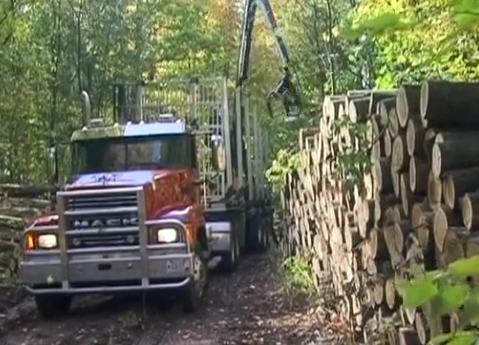Assessing the Wood Supply Chain – Log Truck Research and Logger Survey Updates

Trucking Study
A study funded by the Forest Resources Association (FRA), the Timber Harvesting and Transportation Safety (THATS) Foundation, the Great Lakes Timber Professionals Association (GLTPA), and the University of Minnesota is estimating the safety improvements and efficiency gains that might occur if state legal weight limits for commercial log hauling trucks were increased on selected interstate corridors in Minnesota and Wisconsin. As a part of that, the study compared a) accident rates for log trucks to other heavy trucks and b) the impact of relaxing interstate weight limits on hauling distances, fuel consumption, road damage costs, safety risks, and travel times for timber hauling operations in selected regions within the two states.
Within the lower 48 states, log trucks were safer than other large trucks in 40 states in terms of heavy truck fatality rates per load. Where interstate exemptions exist to allow fully-loaded log trucks on interstates, states with a higher gross vehicle weight for log trucks were safer than other large trucks in 10 of 12 states. States that are relatively heavy producers of timber and have legislation that provide weight-exemption for log trucks (ME, VT, OR, WA) show a decrease of log-trucked based fatality rates relative to other heavy trucks.
An analysis of GPS trackers installed on log trucks in Wisconsin recorded information for nearly 450,000 miles traveled between late January and late August 2021. Using GIS-derived optimal and the actual routes taken, approximately 3,100 loads were compared to alternative routes if those loads had access to an interstate conditional upon ensuring overall weight limits were not exceeded on connecting arterial roads. Some of the findings indicate:
- While there was little change in the distance traveled, access to the interstate would decrease travel time 12-16%.
- The number of points where accidents might incur by driving through communities (e.g., roundabouts, stop signs, traffic lights) along the travel route generally decreased by 30% or more.
- Access to the interstate would reduce fatal crashes by 20%.

An analysis of data from 70 Minnesota townships indicated that travel time and distance to a mill would be reduced in about 70% of the cases through interstate access. Also, the number of roundabouts, stop signs, and traffic lights would be reduced. Additionally, fatal crashes would decrease by 44%.
If you are interested in learning more about this work, please contact FRA’s Tim O’Hara at [email protected]
Logger Surveys
Michigan, Minnesota, and Wisconsin will be conducting surveys of logging business owners in each state beginning in late March of this year to update our knowledge of this important part of the supply chain. Much has changed since the last assessment was conducted five years ago. For example, covid and mill closures have impacted many businesses. Thus, each survey will retain questions from previous years but also provide information about new issues and opportunities.
Individuals within each state have been developing their own survey while also coordinating efforts with representatives from the other states so that ideas are shared, and common questions of interest are worded consistently across the states. As a result, the analyses will tell us more about the health and status of the logging sector in each state while also providing composite information for the three Lake States.

The information learned through these surveys is strengthened through a good response rate. If you or others in your organization interact with logging business owners, please encourage them to complete and return their survey once it arrives during spring breakup. If you are interested in learning more about this work, please contact Tim O’Hara.


